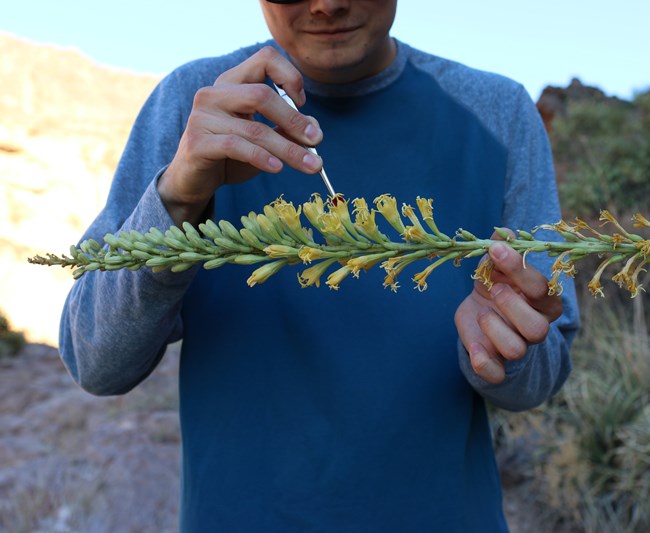Last updated: May 26, 2025
Article
Lesser Long-nosed Bat Research at Organ Pipe Cactus

NPS photo/Sarah Feyers
Lesser long-nosed bat research at Organ Pipe Cactus, 2023
Lesser long-nosed bats have been in scientific focus since the late 1900's. These unique animals face different obstacles in their changing environment, but researchers are at work in Organ Pipe Cactus National Monument, learning more about these bats. Through research here and throughout Central America, scientists are understanding better how to protect these animals and their environment.

NPS photo/Sarah Feyers
Background
Leptonycteris yerbabuenae or the Lesser long-nosed bat is a medium sized bat of Central and North America. These bats are critical pollinators of night blooming cacti such as saguaro and organ pipe, as well as agave, and follow the blooms up into the American southwest in summer. The species was delisted from endangered in 2018, as populations increased. Still, the species faces challenges through loss of habitat and food, disturbance of roosting sites, introduction of invasive species, and climate change.
Though these bats have a limited range in the United States, Organ Pipe Cactus hosts the largest maternity roost in the United States for the lesser long-nosed bat. These bats return annually and give birth when their food-source cacti and agave are in peak bloom. This roost can host over 40,000 bats in a season.
Brandi Stevenson is a master's student at New Mexico State University in Dr. Theresa Laverty's lab. She was in Organ Pipe Cactus National Monument this summer, researching the lesser long-nosed bat. Brandi explores the species’ water drinking behavior, immunology, diet, migratory patterns, and how these characteristics and habits change during different reproductive stages. This information could be crucial in the long-term protection of these charismatic bats.

NPS photo/Sarah Feyers
Effort
Due to the lesser long-nosed bat’s short stay in the National Monument, the researchers operate at high intensity for several weeks in the summer. Research takes place between 6pm and 2am, with some phenology surveys taking place shortly before sunrise.
Once a week, the researchers visit the maternity roost at sunset to catch bats in mist nets as they leave the roost. Two to three nights per week, the researchers visit water sources in the area to net for bats and record other bat activity with an infrared camera. Once per week, the researchers conduct phenology surveys, monitoring saguaro and organ pipe cacti and agave flowering, to assess how much food is on the landscape.
When a bat is captured during netting, researchers weigh, age, and sex the bat, as well as assess its reproductive status. This is conducted with every bat captured. With lesser long-nosed bats specifically, sampling and measuring is more comprehensive. Researchers take a blood and a hair sample, as well as a urine or fecal sample, and assess the bat for ectoparasites. A researcher samples pollen on the bat’s face and finally implants a passive integrative transponder or “PIT-tag” under the bat’s skin.

NPS photo/Sarah Feyers
Results
The PIT-tags implanted in the bats are perceived by antennae located at known roosts within the U.S and Mexico. This provides researchers insight in the species’ movement between countries. Within Organ Pipe Cactus, cameras are set up at known roosts, allowing biologists to conduct regular counts as bats enter and exit the roost.
All the bats are gently handled during the process. For being good sports, they are rewarded with some delicious sugar water, which results in happy bats!
Tags
- casa grande ruins national monument
- chiricahua national monument
- coronado national memorial
- fort bowie national historic site
- glen canyon national recreation area
- grand canyon national park
- grand canyon-parashant national monument
- hubbell trading post national historic site
- lake mead national recreation area
- navajo national monument
- organ pipe cactus national monument
- petrified forest national park
- pipe spring national monument
- saguaro national park
- sunset crater volcano national monument
- tonto national monument
- tumacácori national historical park
- walnut canyon national monument
- wupatki national monument
- bat
- bats
- research
- monitoring
- monitor
- lesser long-nosed bat
- lesser long-nosed bats
- organ pipe cactus national monument
- organ pipe
